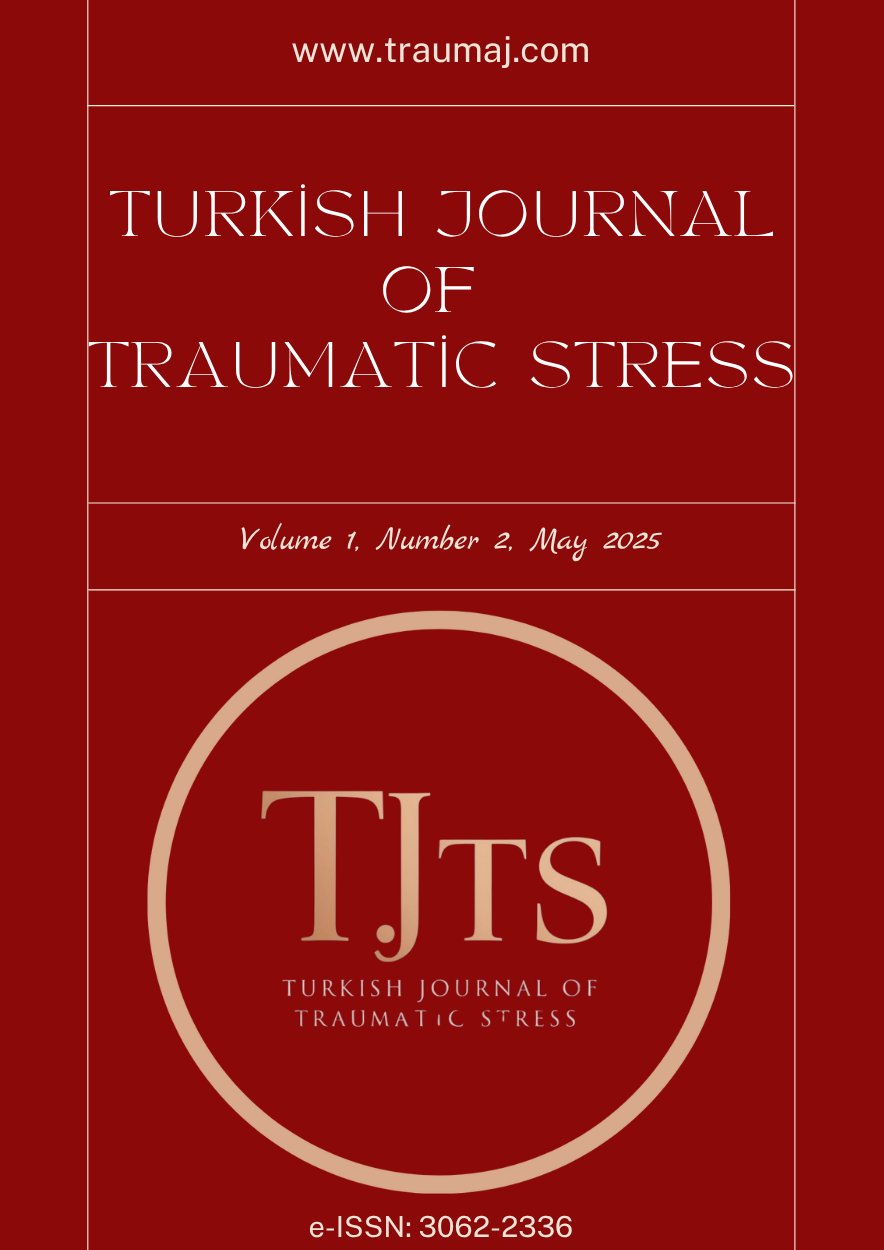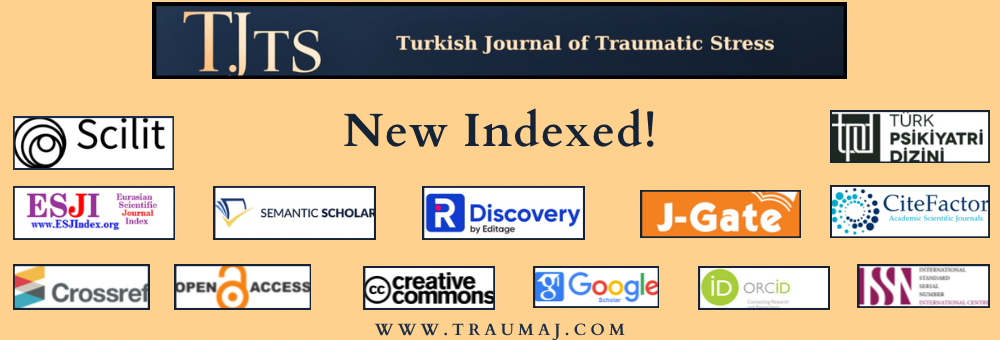The Mediating Role of Impulsivity in The Relationship Between Childhood Traumas and Symptoms Severity in Patients with Obsessive-Compulsive Disorder
The Mediating Role of Impulsivity in The Relationship Between Childhood Traumas and Symptoms Severity in OCD
DOI:
https://doi.org/10.63175/tjts.23Keywords:
Childhood, Compulsion, Impulsivity, Trauma, ObsessionAbstract
Background: Obsessive-compulsive disorder (OCD), marked by persistent obsessions and compulsions, is shaped by genetic, environmental, and psychological factors. Recent research has explored the possible link between childhood trauma and symptom severity. Impulsivity, commonly seen in OCD patients, may worsen symptoms and influence treatment outcomes. This study investigates the link between childhood trauma and OCD severity, focusing on the mediating role of impulsivity.
Methods: The study included 85 OCD patients aged 18–65, either newly diagnosed or under follow-up at Silifke State Hospital. Childhood trauma was assessed using the Childhood Trauma Questionnaire (CTQ), and OCD severity with the Yale-Brown Obsessive Compulsive Scale (Y-BOCS). Impulsivity was measured using the Barratt Impulsiveness Scale (BIS). Appropriate statistical methods were applied to the data.
Results: The sample (mean age = 29.65 ± 9.24) consisted of 34 female participants, representing 40% of the total sample. A significant positive correlation was observed between CTQ scores (excluding sexual abuse) and Y-BOCS scores. Regression analyses showed that CTQ significantly predicted BIS (β = 0.506, p = 0.047), and BIS significantly predicted Y-BOCS (β = 0.538, p = 0.002). Additionally, while the direct effect of CTQ on Y-BOCS was not statistically significant (β= 0.309, SE= 0.578, p= 0.056), BIS was identified as a mediator in the relationship between CTQ and Y-BOCS.
Conclusions: Our findings highlight the importance of considering childhood traumas and impulsivity in OCD treatment. Interventions targeting impulsivity may influence the severity of OCD symptoms and could be beneficial when integrated into treatment protocols. More research is needed to uncover the relationship between childhood trauma and OCD.
References
1. American Psychiatric Association. Diagnostic and Statistical Manual of Mental Disorders. 5th ed. Arlington, VA: American Psychiatric Association; 2013: 947. doi:10.1176/appi.books.9780890425596
2. Eisen JL, Mancebo MA, Pinto A, et al. Impact of obsessive-compulsive disorder on quality of life. Compr Psychiatry. 2006;47(4):270-275. doi:10.1016/j.comppsych.2005.11.006
3. Bogetto F, Venturello S, Albert U, Maina G, Ravizza L. Gender-related clinical differences in obsessive-compulsive disorder. Eur Psychiatry. 1999;14(8):434-441. doi:10.1016/S0924-9338(99)00224-2
4. Fineberg NA, Hengartner MP, Bergbaum CE, et al. A prospective population-based cohort study of the prevalence, incidence and impact of obsessive-compulsive symptomatology. Int J Psychiatry Clin Pract. 2013;17(3):170-178. doi:10.3109/13651501.2012.755206
5. Hartl TL, Duffany SR, Allen GJ, Steketee G, Frost RO. Relationships among compulsive hoarding, trauma, and attention-deficit/hyperactivity disorder. Behav Res Ther. 2005;43(2):269-276. doi:10.1016/j.brat.2004.02.002
6. Lochner C, du Toit PL, Zungu-Dirwayi N, et al. Childhood trauma in obsessive-compulsive disorder, trichotillomania, and controls. Depress Anxiety. 2002;15(2):66-68. doi:10.1002/da.10028
7. Demirci K. The investigation of relationship between childhood trauma and obsessive-compulsive symptoms. Psychiatry Behav Sci. 2016;6(1):7
8. Barzilay R, Patrick A, Calkins ME, Moore TM, Gur RC, Gur RE. Association between early-life trauma and obsessive compulsive symptoms in community youth. Depress Anxiety. 2019;36(7):586-595. doi:10.1002/da.22907
9. Cloitre M, Cohen LR, Edelman RE, Han H. Posttraumatic stress disorder and extent of trauma exposure as correlates of medical problems and perceived health among women with childhood abuse. Womens Health (Lond Engl). 2001;34(3):1-17. doi:10.1300/J013v34n03_01
10. Perry JC, Roy CA, Simon B. Gross overall psychological trauma in relationship to Axes I and II and overall functioning. Can J Psychoanal. 2004;12(2):252
11. Kessler RC, McLaughlin KA, Green JG, et al. Childhood adversities and adult psychopathology in the WHO World Mental Health Surveys. Br J Psychiatry. 2010;197(5):378–385. doi:10.1192/bjp.bp.110.080499
12. Kessler RC, Davis CG, Kendler KS. Childhood adversity and adult psychiatric disorder in the US National Comorbidity Survey. Psychol Med. 1997;27(5):1101–1119. doi:10.1017/S0033291797005588
13. Cox BJ, MacPherson PS, Enns MW. Psychiatric correlates of childhood shyness in a nationally representative sample. Behav Res Ther. 2005;43(8):1019–1027.
14. Green JG, McLaughlin KA, Berglund PA, et al. Childhood adversities and adult psychiatric disorders in the National Comorbidity Survey Replication I: associations with first onset of DSM-IV disorders. Arch Gen Psychiatry. 2010;67(2):113–123. doi:10.1001/archgenpsychiatry.2009.186
15. Kempke S, Luyten P, Claes S, et al. The prevalence and impact of early childhood trauma in chronic fatigue syndrome. J Psychiatr Res. 2013;47(5):664–669. doi:10.1016/j.jpsychires.2013.01.021
16. Özdemir PG, Selvi Y, Aydın A. Impulsivity and Its Treatment Clin Anal Psychiatr. 2012;4(3):293–314. doi:10.5455/cap.20120418
17. Belli H, Ural C, Yesilyurt S, Vardart MK, Akbudak M, Oncu F. Childhood trauma and dissociation in patients with obsessive compulsive disorder. West Indian Med J. 2013;62(1):39–44.
18. Visser HA, van Minnen A, van Megen H, et al. The relationship between adverse childhood experiences and symptom severity, chronicity, and comorbidity in patients with obsessive-compulsive disorder. J Clin Psychiatry. 2014;75(10):1034–1039. doi:10.4088/JCP.13m08825
19. Bey K, Lennertz L, Riesel A, et al. Harm avoidance and childhood adversities in patients with obsessive-compulsive disorder and their unaffected first-degree relatives. Acta Psychiatr Scand. 2017;135(4):328–338. doi:10.1111/acps.12707
20. Kart A, Türkçapar H. The effects of childhood emotional abuse on aggressive obsessions among patients with obsessive compulsive disorder may be mediated by symptoms of depression and anxiety. Psychiatry Clin Psychopharmacol. 2019;29(4):411–417. doi:10.1080/24750573.2019.1636483
21. Namlı Z, Tamam L, Demirkol ME, Karaytuğ MO, Sun T. The relationship among autistic traits, impulsivity, and functionality in patients with obsessive-compulsive disorder. J Nerv Ment Dis. 2023;211(3):195–202. doi:10.1097/NMD.0000000000001601
22. Sohn SY, Kang JI, Namkoong K, Kim SJ. Multidimensional measures of impulsivity in obsessive-compulsive disorder: cannot wait and stop. PLoS One. 2014;9(11):e111739. doi:10.1371/journal.pone.0111739
23. Benatti B, Dell’Osso B, Arici C, Hollander E, Altamura AC. Characterizing impulsivity profile in patients with obsessive-compulsive disorder. Int J Psychiatry Clin Pract. 2014;18(3):156–160. doi:10.3109/13651501.2013.855792
24. Summerfeldt LJ, Hood K, Antony MM, Richter MA, Swinson RP. Impulsivity in obsessive–compulsive disorder: comparisons with other anxiety disorders and within tic-related subgroups. Pers Individ Dif. 2004;36(3):539–544. doi:10.1016/S0191-8869(03)00113-2
25. Uzunoğlu SY, Beştepe EE, Ayık B. Evaluation of the relationship between disease severity and difficulties in emotion regulation, impulsivity, and quality of life in untreated patients diagnosed with obsessive-compulsive disorder. Psychiatry Investig. 2025;22(3):320–329. doi:10.30773/pi.2024.0261
26. Richard-Lepouriel H, Kung AL, Hasler R, et al. Impulsivity and its association with childhood trauma experiences across bipolar disorder, attention deficit hyperactivity disorder and borderline personality disorder. J Affect Disord. 2019;244:33–41. doi:10.1016/j.jad.2018.07.060
27. Goodman WK, Price LH, Rasmussen SA, Mazure C, Fleischmann RL, Hill CL, et al. The Yale-Brown Obsessive Compulsive Scale. I. Development, use, and reliability. Arch Gen Psychiatry. 1989;46(11):1006–1011. doi:10.1001/archpsyc.1989.01810110048007
28. Goodman WK, Price LH, Rasmussen SA, et al. The Yale-Brown Obsessive Compulsive Scale. II. Validity. Arch Gen Psychiatry. 1989;46(11):1012–1016. doi:10.1001/archpsyc.1989.01810110054008
29. Koçoğlu F, Safrancı Bahtiyar B. Yale-Brown Obsession Compulsion Scale–Turkish Self Report Form: a study of reliability and validity. Klin Psikol Derg. 2021;5(1):1. doi:10.5455/kpd.26024438m000047
30. Bernstein DP, Fink L, Handelsman L, Foote J, Lovejoy M, Wenzel K, et al. Initial reliability and validity of a new retrospective measure of child abuse and neglect. Am J Psychiatry. 1994;151(8):1132–1136. doi:10.1176/ajp.151.8.1132
31. Şar V, Öztürk E, İkikardeş E. Validity and reliability of the Turkish version of Childhood Trauma Questionnaire. Turk Klin J Med Sci. 2012;32(4):1054–1063. doi:10.5336/medsci.2011-26947
32. Patton JH, Stanford MS, Barratt ES. Factor structure of the Barratt Impulsiveness Scale. J Clin Psychol. 1995;51(6):768–774.
33. Güleç H, Tamam L, Yazıcı-Güleç M, et al. Psychometric properties of the Turkish version of the Barratt Impulsiveness Scale-11. Klin Psikofarmakol Bul. 2008;18(3):251–258.
34. IBM Corp. IBM SPSS Statistics for Windows, Version 22.0. Armonk, NY: IBM Corp.; 2013.
35. Hayes AF. Introduction to mediation, moderation, and conditional process analysis: a regression-based approach. New York, NY: Guilford Press; 2013.
36. Gürbüz S. Mediator, moderator and situational effect analyses in social sciences. Ankara, Turkey: Seçkin Publishing; 2019.
37. Preacher KJ, Hayes AF. Asymptotic and resampling strategies for assessing and comparing indirect effects in multiple mediator models. Behav Res Methods. 2008;40(3):879–891.
38. De Rossi E, Imperatori C, Sciancalepore F, et al. Childhood trauma, mentalization and obsessive compulsive symptoms in a non-clinical sample: a mediation analysis study. Clin Neuropsychiatry. 2024;21(3):195–204. doi:10.36131/cnfioritieditore20240305
39. Boger S, Ehring T, Schwarzkopf W, Werner GG. Potential mediators of the association between childhood maltreatment and obsessive-compulsive disorder in adulthood. J Obsessive-Compuls Relat Disord. 2020;27:100587. doi:10.1016/j.jocrd.2020.100587
40. Hollander E, Wong CM. Obsessive-compulsive spectrum disorders. J Clin Psychiatry. 1995;56(suppl 4):3–55.
41. Çoban A, Tan O. Attention Deficit Hyperactivity Disorder, Impulsivity, Anxiety, and Depression Symptoms Mediating the Relationship Between Childhood Trauma and Symptoms Severity of Obsessive-Compulsive Disorder. Noro Psikiyatr Ars. 2020;57(1):37–42. doi:10.29399/npa.23654
42. Boisseau CL, Thompson-Brenner H, Caldwell-Harris C, Pratt E, Farchione T, Barlow DH. Behavioral and cognitive impulsivity in obsessive-compulsive disorder and eating disorders. Psychiatry Res. 2012;200(2–3):1062–1066. doi:10.1016/j.psychres.2012.06.005
43. Snorrason Í, Smári J, Ólafsson RP. Motor inhibition, reflection impulsivity, and trait impulsivity in pathological skin picking. Behav Ther. 2011;42(3):521–532. doi:10.1016/j.beth.2010.12.002
44. Ou W, Li Z, Zheng Q, Chen W, Liu J, Liu B, Zhang Y. Association between childhood maltreatment and symptoms of obsessive-compulsive disorder: a meta-analysis. Front Psychiatry. 2021;11:612586. doi:10.3389/fpsyt.2020.612586
45. Demirci K. The investigation of relationship between childhood trauma and obsessive-compulsive symptoms. Journal of Mood Disorders. 2016;6(1):7-13. Doi: 10.5455/jmood.20160303113111
46. Mathews CA, Kaur N, Stein MB. Childhood trauma and obsessive-compulsive symptoms. Depress Anxiety. 2008;25(9):742–746. doi:10.1002/da.20316
47. Kim JH, Choi JY. Influence of childhood trauma and post-traumatic stress symptoms on impulsivity: focusing on differences according to the dimensions of impulsivity. Eur J Psychotraumatol. 2020;11(1):1796276. doi:10.1080/20008198.2020.1796276
48. Agnew R, Thaxton S, Brezina T. Does victimization reduce self-control? A longitudinal analysis. J Crim Justice. 2011;39(3):169–174. doi:10.1016/j.jcrimjus.2011.01.005
49. Brodsky BS, Oquendo M, Ellis SP, Haas GL, Malone KM, Mann JJ. The relationship of childhood abuse to impulsivity and suicidal behavior in adults with major depression. Am J Psychiatry. 2001;158(11):1871–1877. doi:10.1176/appi.ajp.158.11.1871
50. Evren C, Cınar Ö, Evren B, Ulku M, Karabulut V, Umut G. The mediator roles of trait anxiety, hostility, and impulsivity in the association between childhood trauma and dissociation in male substance-dependent inpatients. Compr Psychiatry. 2013;54(2):158–166. doi:10.1016/j.comppsych.2012.06.013
Published
How to Cite
Issue
Section
License
Copyright (c) 2025 Cansu Ünsal Mavi, Esra Yalım, Mehmet Rıdvan Varlı

This work is licensed under a Creative Commons Attribution 4.0 International License.








